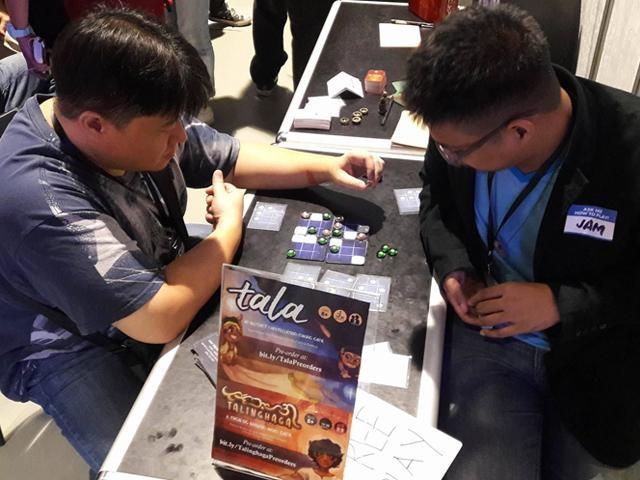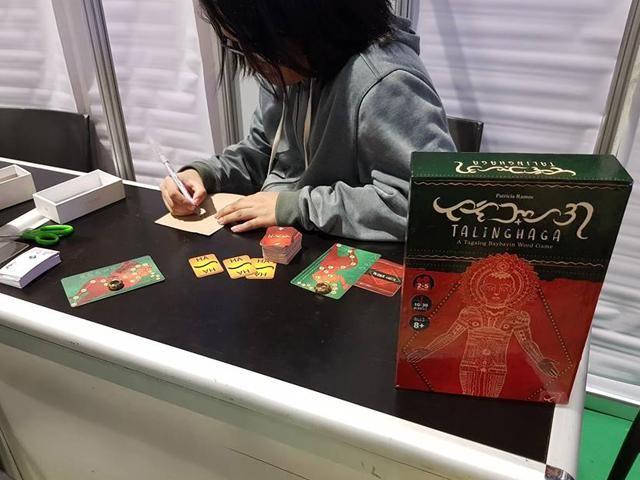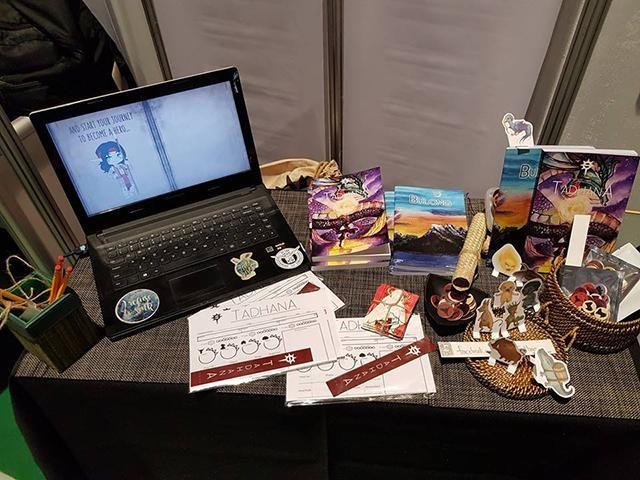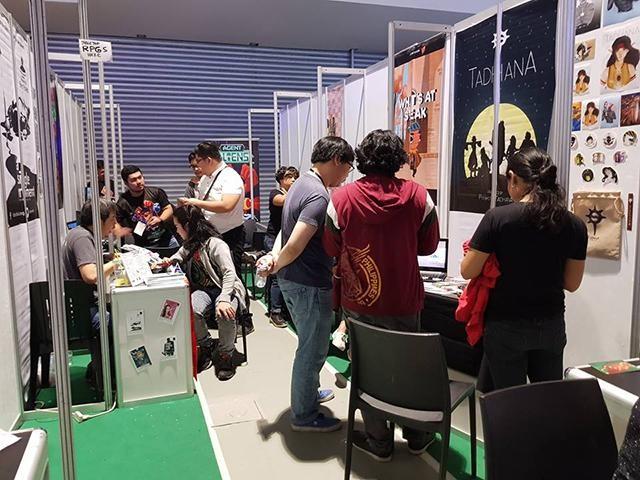Philippine tabletop gaming’s resurgence highlighted at ESGS 2017
When people think of gaming conventions, video games are what usually come to mind. But at the E-Sports and Gaming Summit (ESGS) 2017, attendees witnessed something special: the welcome and long-overdue presence of tabletop gaming in the form of board games, card games, and role-playing games (RPGs).
For the tabletop game developers at ESGS 2017, being invited to the previously video games-only event was a pleasant surprise.
“When I was told there would be booths for tabletop game developers, it was extremely appreciated,” said Tobie Abad, who exhibited his 2-player tabletop RPG, “A Single Moment,” at ESGS 2017. “It shows that tabletop gaming has a place in gaming as a whole.”
The following are but a few of the Filipino developers who showcased their tabletop games at ESGS 2017.
Tala

“Tala” is a 15-minute 2-player game about making constellations. Players draw 3 constellation cards, then recreate each starry pattern by placing tokens (stars) on a board (sky). You claim a card when you complete its pattern; the first to acquire 3+ cards wins.
Oddly enough, “Tala” wouldn’t be the game it is today without “Counter-Strike.”
“I made this prototype for a board game inspired by ‘Counter-Strike,’ ” said “Tala” designer Juan Miguel Ala-Tolentino. “To make the map, you had to put together map tiles. One day, I was playing the game when I accidentally placed some of my tokens on one of the tiles. For some reason, the pattern formed by the tokens reminded me of ‘Tic Tac Toe.’”
The game continued to evolve.
“The first version of ‘Tala’ was ‘Burda,’ because the place-a-token-take-a-token motion reminded me of sewing. Much later, ‘Burda’ became ‘Tala’ when I noticed the tiles kind of looked like the sky, with clouds where you can’t place tokens (because stars aren't visible from behind clouds).”
He also preferred the idea of making constellations because it “makes players into cosmic gods.”
Tolentino designed the game to be both simple and complex:
“Games like ‘Tic Tac Toe’ and ‘Go’ have relatively few rules, but while the former has very little complexity, the latter has almost overwhelming complexity. I wanted ‘Tala’ to fall somewhere in the middle, where it would be simple enough to be accessible, but complex enough to feel engaging.”
Talinghaga

“Talinghaga” revolves around the ancient Tagalog script, Baybayin. Lasting over 30 minutes and playable by 2 to 5 players, it’s a “word game where players create, steal, and collect words in a tableau to get the most number of points in the game,” explained co-designer Patricia Ramos.
“Talinghaga started as my undergraduate thesis and I wanted to showcase or teach something Filipino,” stated Ramos. “I've always been interested in Baybayin and wanted to learn it for myself, so I thought that this would be the perfect opportunity to make it my focus.”
As co-designer, Tolentino helped Ramos with the mechanics:
“The game went through a lot of versions, the latest of which we believe is accessible for players young and old alike.”
Most Filipinos today know little about Baybayin. “Talinghaga” therefore has educational value.
“We have a lot of people still coming up to us and asking about ‘alibata’ when we try to clarify that the correct term is ‘Baybayin,’” said Ramos. “We made sure to really incorporate the ancient Tagalog theme and apply it in our graphics and art. Of course, we also tried to make the mechanics as enjoyable as possible so that people will want to learn more about Baybayin and Tagalog beyond the game.”
Many who have enjoyed “Talinghaga” have expressed great interest in the local language.
“The game is an opportunity for players to deconstruct Tagalog, a language that many of us speak every day but don’t really think about that much,” Tolentino said.
“Playing the game has led many of our players into a newfound appreciation of our language.”
Students at the Alternative Learning Center in Tagaytay are already playing “Talinghaga” as a way to practice their Tagalog grammar.
We can thank Ramos for “Tala” and “Talinghaga’s” beautiful art. To her, designing game art is a complex process:
“I have to think about how the art works in tandem with the function of the game as it’s better to have something that works well as opposed to being purely ornamental, or worse, something that's pretty but works against the gameplay.”
Game art design also requires extensive research:
“A lot of research went into ‘Talinghaga’ to make the elements accurate and to help the players feel immersed in that time period.”
Visit The Art of Patti Ramos Facebook page for “Tala” and “Talinghaga” pre-order links and updates.
Hugot
From Thomas Regala of The Epic Gaming Regiment (TEGR) comes “Hugot,” a card game for 3 to 10 players.
“Hugot” revolves around the Filipino hugot culture. It’s a bit like “Cards Against Humanity”: one player draws a card featuring a question or statement, then the other players lay down cards that best express their thoughts and feelings in relation to said question/statement. The player with the best “hugot” wins the card, and play continues around the table until someone obtains 5 cards.
“Hugot is everywhere nowadays,” said Regala. “It’s become engraved in the Filipino psyche. I think it’s about time we had a game that tackles it.”
Feedback on “Hugot” has been positive:
“A lot of people have been giving me good stories, like the game would get people opening up about their exes, which can make play very interesting.”
Developing “Hugot” came naturally to Regala:
“At that time I was going through a heartbreak. This served as an inspiration, and the game became a coping mechanism. It only took me around a week to create the game idea, but a month to create the cards and the questions themselves.”
Ludus’ Freddie Tan realized there was a market for “Hugot” after observing his crew enjoying the game. Now Ludus is the game’s publisher.
“Hugot” is available in game shops such as Neutral Grounds. Check out TEGR’s Facebook page for more information.
Tadhana

Project Tadhana was also at ESGS 2017 to exhibit “Tadhana,” a tabletop RPG based on Filipino myths and legends.
“As much as I love video games, it’s time gamers became aware of tabletop games as well,” said the game’s lead writer and developer John Nathaniel Briones.
“Tadhana’s” core rules are already final, but Briones revealed there’s more content coming to the RPG:
“We’ll be adding more campaigns in the future. There’s an expansion coming out next year, maybe around March. It’ll include a bestiary, which covers the monsters you’ll encounter in the game. There will also be an Overseer’s guide, and some expansions to the Professions like multiclasses, prestige classes, and more.”
Briones has high hopes for “Tadhana”:
“If we can sustain this, we’re planning for ‘Tadhana’ to be a continuous campaign, a longstanding series. Hopefully a franchise, if people make it possible.”
Visit Project Tadhana’s Facebook page for more “Tadhana” details.

The rise of Filipino tabletop gaming
The past couple of years have seen a tabletop gaming renaissance.
“The emergence of the concept of gaming cafés has greatly supported tabletop’s resurgence, because it allows people who don’t normally buy tabletop games, or who’ve only heard about them, to actually try them out for themselves,” stated Abad.
“I also think the internet has hugely affected tabletop gaming. Getting information about existing games is now so easy. Before you had to literally be in the know or know the right people; now you can simply do an online search, and you’ll find information about games.”
Tabletop gaming’s revival is influencing the re-emergence of Filipino tabletop game developers.
“There are a lot of the ambitious people now who are being very brave about creating tabletop games and sharing them with the world,” said Abad. “Many of them are quite young, or are people who weren’t into gaming during the 90s… I’m lucky enough to have the perspective of someone who’s been into gaming since the early 90s, so I do what I can to help others be aware of what happened before so they can learn from the mistakes of the past.” — BM, GMA News




